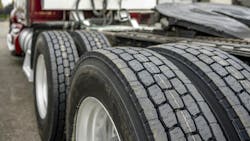My generation represents the last of the real risk-takers. We rode bikes without helmets on the shoulders of busy highways and drank water out of hoses wherever we could find them. Streetlights were the universal signal that it was time to head home for the night. Everyone, myself included, had a beat-up old car because all it had to do was run. There were no emission tests, inspections, or seat belt laws back then. Looking back, it’s incredible we survived the ’80s.
For the past 40-plus years, singling out a tire in a dual application has been widely accepted and practiced. The concept is simple enough. A dual tire fails, and rather than purchase a replacement, the fleet decides to operate the vehicle with three tires on the axle instead of four. It typically applies to an empty vehicle or one with a light load; in theory, there is enough inflation pressure to support the weight on the single tire in that position to get the vehicle to a repair facility.
As long as the single tire has enough weight-carrying capacity for the load, an out-of-service condition would not exist. Enforcement officials can note that the vehicle is empty, so the tire load limit should be sufficient, or they can use the portable scale to check. Regarding an OOSC, the outcome depends on the actual weight on the axle and whether the single tire’s inflation pressure and load limit can support the weight on that side.
The debate focuses on 49 CFR Part 571.120, which covers the tire and rim selection and load-carrying capacity information for motor vehicles with a gross vehicle weight rating of over 10,000 lb. Part 571.120 is one of many Federal Motor Vehicle Safety Standards that apply to all vehicles operating in the United States. The regulations are directed at manufacturers by setting performance and labeling requirements and establishing other measures that improve motor vehicle safety. In this case, the requirements in S5.1.2 are central to the debate.
See also: Tire monitoring benefits fleets
FMVSS 571.120 S5.1.2 states the sum of the maximum load ratings of the tires fitted to an axle cannot be less than the gross axle weight rating (GAWR) of the axle system specified on the vehicle certification label required by 49 CFR part 576. In other words, if a truck or trailer has a GAWR of 20,000 lb., then the tires on that axle must be capable of supporting 20,000 lb. regardless of the load.
A 295/75R22.5 Load Range G tire has a maximum capacity of 5,675 lb. at 110 psi. When there are four tires across the axle, no violation exists. When one of the dual tires is singled out, the maximum load rating would be 17,525 lb. (5,675 x 2 plus 6,175 for the single). The math either adds up or doesn’t.
Complicating the matter is 49 USC 30122, which covers making safety devices and elements inoperative. It defines a “motor vehicle repair business” as “a person holding itself out to the public to repair for compensation a motor vehicle or motor vehicle equipment.” The prohibition requirement under paragraph (b) states that a “motor vehicle repair business may not knowingly make inoperative any part of a device or element of design installed on or in a motor vehicle or equipment in compliance with an applicable motor vehicle safety standard.”
The design element prescribed in 571.120 requires the sum of the tire capacity on the axle to meet the GAWR. When a motor vehicle repair business singles out a 295/75R22.5 on a vehicle with a GAWR of 20,000 lb., it would appear they are violating 571.120 due to 30122(b). In this instance, the inflation pressure and actual load on the tire would be irrelevant because the combined maximum load capacity does not add up. So, they knowingly made it inoperative by removing and not replacing a tire.
Compliance aside, motor vehicle repair businesses like commercial tire dealers are at greater risk when they single out a tire. In the event of an accident involving that vehicle, the plaintiff will point to the violation of 571.120, 30122(b), or both as contributing factors. As commercial tire dealers become aware of the requirements, the number of companies refusing to single out dual tires is rising.
It’s just not worth the risk.
About the Author
Kevin Rohlwing
Kevin Rohlwing is the SVP of training for the Tire Industry Association. He has more than 40 years of experience in the tire industry and has created programs to help train more than 180,000 technicians.
